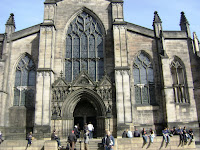We left Durham on our way to the coast, hoping to stay in a B & B in Whitby. But alas it was not to be. It turns out Brits love to go to the country or the seashore for holidays, and it turns out they are getting some extra "bank holidays" this month. Possibly due to the Royal Wedding that is coming up. At any rate all of the B & B's in Whitby were booked, so we kept driving on toward London, thinking we would certainly find a place to stay by the time we got to Pickering. Luckily we found Netherby House, just outside Whitby and on the edge of the moors. It is a big old house that was once owned by a doctor who also performed surgery there, and his patients would then convalesce in one of the four bedrooms. There is a garden in the back, and this fantastic view:

It is now a great B & B that also serves dinner! We were pretty tired (being tourists in Durham then driving all over Whitby looking for a place to stay) and were beginning to feel a little bit like this couple looks:

After a great dinner, a good night's sleep and Egg Benedict for breakfast, we were ready to set out again, to cross the moors and find London. It turns out that moors are just hills with heather (and not much else) growing on them. This time of year the heather is brown. The host at Netherby House told us that in August they bloom purple. It must be a beautiful sight.
We finally made it to London and took the tubes out to Southfields where we had an apartment reserved. We stopped by the public library to use the Internet (we've been deprived for the past few days), then got ourselves checked in. It is a small studio apartment but it has a washer/dryer combination so we are ecstatic! The first night we rode the tube down to the British Library to see the British Treasures room. They have some original scores from Beethoven and Schubert, a first folio from Shakespeare, and a 4th century New Testament. And they have one of the four existing copies of the Magna Carta! Originally signed by King John in 1215, it was an attempt by the feudal barons to limit the power of the king. One of its most memorable declarations is that "no free man shall be taken or imprisoned...but by lawful judgement of his Peers, or by the Law of the Land." It also has language that is reflected in our habeus corpus and Bill of Rights.
The next day we went back into the city to tour the Globe Theater, This is of course not the original, which was destroyed by fire in 1613 when they fired a wad from a real cannon for special effects, nor is it even the 2nd Globe, which went to ruins. It is the 3rd, built by American actor Sam Wanamaker in the 1950's, with charitable donations from all over the world. It is as close to the original as they could make it, including a thatch roof (don't worry...this time they installed a sprinkler system). We toured the theater in the afternoon and returned in the evening to see a production of "All's Well That Ends Well." It was the story of a young man who tries to escape matrimony by placing conditions upon the marriage that he is certain cannot be met. But of course the lady is in love and so she is determined and manages to find a way to meet his conditions. It was by far the best performance of Shakespeare that I've ever seen. Sitting on the wooden bench in the open air for over two hours (we could have stood for only 5 pounds) was not as bad as it may sound. We rented cusions to sit on and were allowed to take food and drinks into the theater. For a souvenir I bought a replica of the folio of King Lear for 12.50 pounds.

Before showtime we had time to tour the Tate Modern Museum of Art, which was right next door. We are not huge fans of modern art, but we saw some pieces that we liked, such as this one (Picasso's Three Dancers):

The next day we decided to take it easy and buy tour bus tickets. The first tour guide we had told us he had been to Snellville, as an exchange student, in 1981-82! He went to Snellville Middle School. What a small world it is. We rode the bus around the city for more than 2 hours! Here's a view of the big Ferris Wheel:

Finally we hopped of for a closer look at Buckingham Palace. Today there were lots of people, and we spotted someone from Her Majesty's Secret Service outside keeping an eye on the crowd. The Queen is currently in residence, since she will no doubt be attending the wedding at Westminster Abbey tomorrow morning at 11:00 AM.






















































